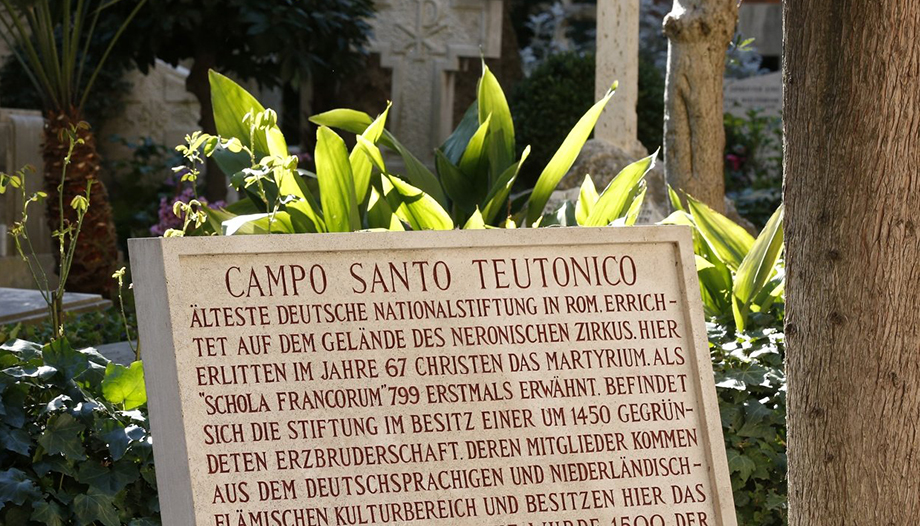Despite its small size (less than 300 square meters including the church) it has a long history and became an institution dating back to the dawn of Christianity, in particular with Charlemagne.
But it is also intertwined with recent history, "The institution became the headquarters of a clandestine organization that was in charge of protecting and hiding Jews and other persecuted people during the Nazi occupation, as recalled in the 1983 film 'The Scarlet and The Black' with Gregory Peck", explains to Omnes, the priest and historian Johannes Grohe, vice director of the Goerres Institute and member of the "Arciconfraternita at Campo Santo Teutonico".
"The Irish priest Hugh O'Flaherty (1889-1963), of the Diplomatic Service of the Holy See, who had his residence in the structures of the Cemetery, allowed about 6,500 among persecuted and Jews to be saved, making them take refuge in the Vatican and its residences, like the 12,000 that Pius XII hid in Castel Gandolfo" he explains.
"Thanks to the so-called 'Escape Line' which had - continues Johannes Grohe - the support of the British ambassador Francis D'Arcy. OsborneThe Italian princess Elvina Pallavicini, who took refuge in the former Santa Marta Residence, and the Italian princess Elvina Pallavicini, who in turn took refuge in the structures of the Cemetery, managed to obtain false documents that allowed people in danger of their lives to leave the country, thus circumventing the Gestapo's controls. In the meantime, the Nazi hierarch and war criminal Herbert Kappler never managed to catch O'Flaherty, although 5 of his collaborators ended up shot in the Ardeatine Graves.
Mr. Johannes Grohe, who is also a professor at the Pontifical University of the Holy Cross recalls that Hugh O'Flaherty was called "The Scarlet Pimpernel of the Vatican" (hence the title of J. P. Gallagher's 1967 book, which inspired the aforementioned film), and that to show the Resistance that he was always there, he prayed by walking in the area in front of St. Peter's Basilica, making the refugees enter through the paths adjacent to the now demolished Petriano Museum, next to the Holy Office.
The "Camposanto dei Teutonici e dei Fiamminghi" in German: "Friedhof der Deutschen und der Flamen", and its structures are located on the site of the Roman circus where the Apostle Peter was martyred, today between the Paul VI Hall - where the audiences are held - and St. Peter's Basilica.
Once the Circum Neronianum fell into disuse, many Christians wanted to be buried in that necropolis, near the tomb of the holy apostle.
The Teutonic cemetery is mentioned for the first time by documents in 799, and seems to have been founded by Charlemagne himself or related to his figure thanks to the foundation of the "Schola Francorum", certainly the oldest Germanic institution in Rome, which joined other Nordic institutions: that of the Longobards, Frisians and Saxons, the latter with the present church of "Santo Spirito in Sassia".
In fact, during the period of the coronation of Charlemagne, the Holy Roman Emperor, pilgrims came to Rome from all corners of the empire and it was necessary to give them hospitality and to have a cemetery to give dignified burial to those who died in the Eternal City.
Thus, as early as the 13th century, the early medieval Schola Francorum, run by the clergy, included two churches, the hospice for pilgrims and the poor, as well as the cemetery. One of these churches, the adjoining "Santa Maria della Pietà", manages the cemetery and to this day the rules for burial there require a German mother tongue and residence in Rome.
Restored in 1454 German members of the Roman Curia gave funds for a total reconstruction including the church. In 1597 the "Arciconfraternità di Nostra Signora" was created with headquarters next to the Teutonic Cemetery.
With the impulse of its rector, Anton de Waal, a residence for priests studying history and sacred archaeology was built in 1876, and some of them took part in the excavations in Rome. In 1888 the Roman Institute of the Society of Goerres was added.
Johannes Grohe explains, "The Institute and the residence, today "Pontifical Collegio", have a library with more than 50,000 books, which also contains a "Ratzinger/Benedetto XVI Library, with his works, in editions in many languages, and on his theology".
In addition, "Cardinal Ratzinger, who was a member of the Archconfraternity and the Society of Goerres, had lived at the Collegio for a period before moving to Piazza Leonina and being elected Pontiff, and had the custom of celebrating Holy Mass every Thursday in the Church of Campo Santo. In 2015 he celebrated the H. Mass in this church for the last time, with his theology alumni, the famous "Schülerkreis" cocluye don Johannes Grohe.
Konrad Bestle, and the director of the Historical Institute of the "Istituto Goerres al Campo Santo Teutonico" is the historian and rector of the "Pontificio Istituto di Archeologia Sacra", Msgr. Stefan Heid.









